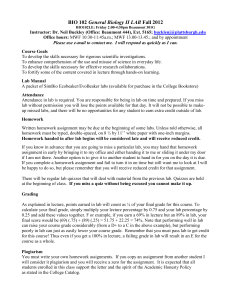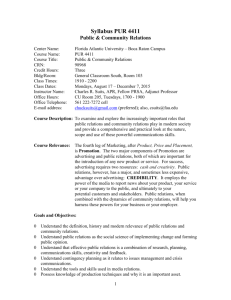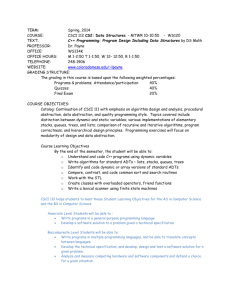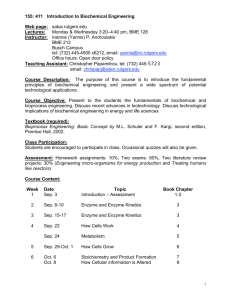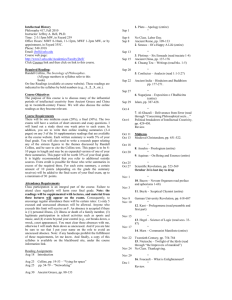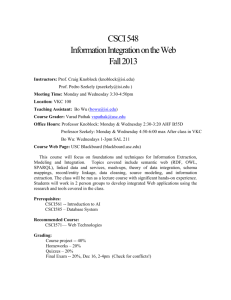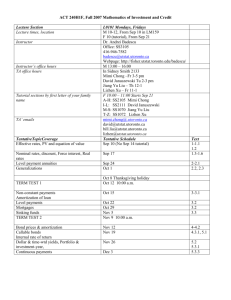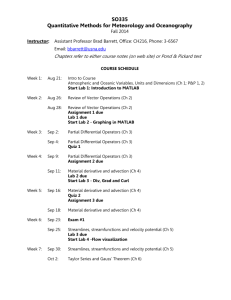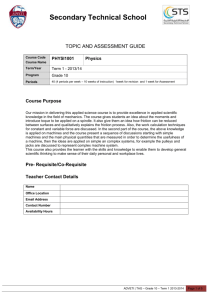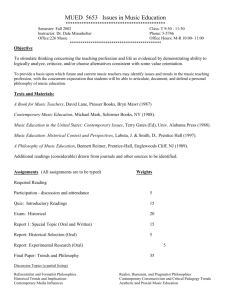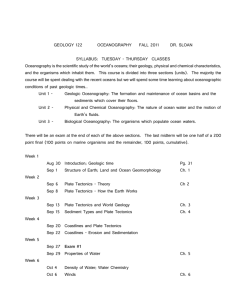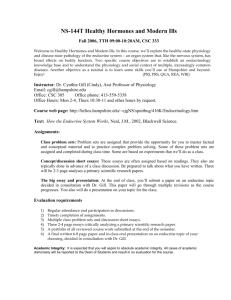Syllabus 1. Course number and name: BENG 499 (undergraduate
advertisement
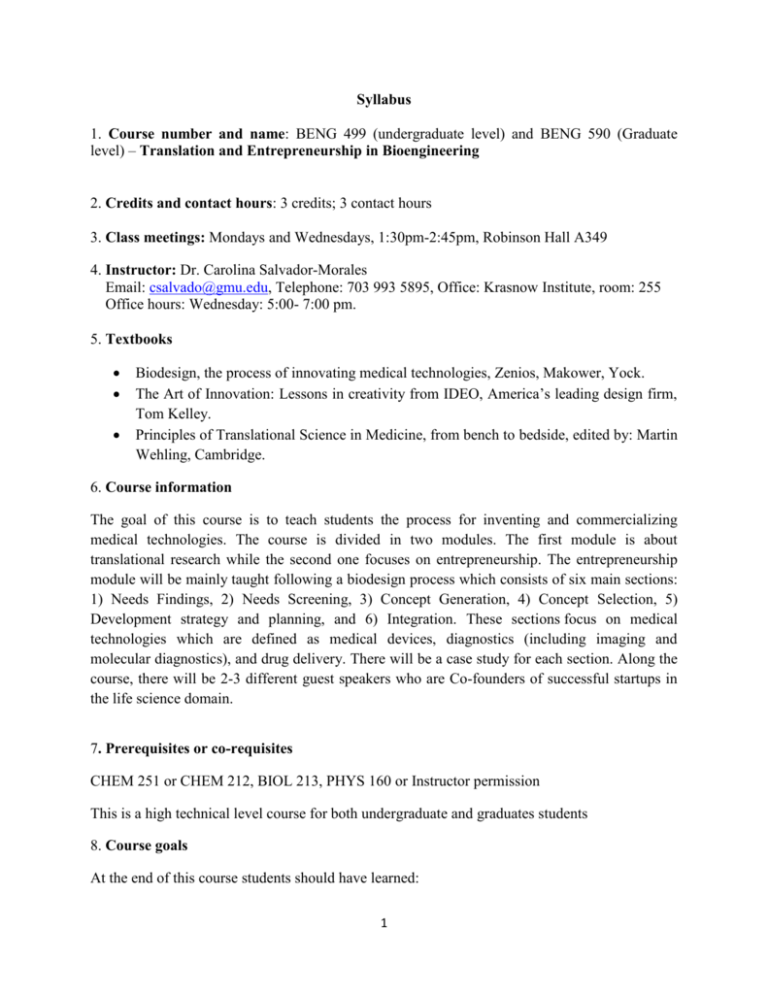
Syllabus 1. Course number and name: BENG 499 (undergraduate level) and BENG 590 (Graduate level) – Translation and Entrepreneurship in Bioengineering 2. Credits and contact hours: 3 credits; 3 contact hours 3. Class meetings: Mondays and Wednesdays, 1:30pm-2:45pm, Robinson Hall A349 4. Instructor: Dr. Carolina Salvador-Morales Email: csalvado@gmu.edu, Telephone: 703 993 5895, Office: Krasnow Institute, room: 255 Office hours: Wednesday: 5:00- 7:00 pm. 5. Textbooks Biodesign, the process of innovating medical technologies, Zenios, Makower, Yock. The Art of Innovation: Lessons in creativity from IDEO, America’s leading design firm, Tom Kelley. Principles of Translational Science in Medicine, from bench to bedside, edited by: Martin Wehling, Cambridge. 6. Course information The goal of this course is to teach students the process for inventing and commercializing medical technologies. The course is divided in two modules. The first module is about translational research while the second one focuses on entrepreneurship. The entrepreneurship module will be mainly taught following a biodesign process which consists of six main sections: 1) Needs Findings, 2) Needs Screening, 3) Concept Generation, 4) Concept Selection, 5) Development strategy and planning, and 6) Integration. These sections focus on medical technologies which are defined as medical devices, diagnostics (including imaging and molecular diagnostics), and drug delivery. There will be a case study for each section. Along the course, there will be 2-3 different guest speakers who are Co-founders of successful startups in the life science domain. 7. Prerequisites or co-requisites CHEM 251 or CHEM 212, BIOL 213, PHYS 160 or Instructor permission This is a high technical level course for both undergraduate and graduates students 8. Course goals At the end of this course students should have learned: 1 1. 2. 3. 4. The process of translational research How to innovate in science The process involved in the commercialization of scientific discoveries The process involved in the creation of a start-up Calendar: Class 1 (M). Aug 26. Overview of translational research and entrepreneurship Class 2 (W). Aug 28. Definition of translation research and key examples (e.g., biomarkers) Class 3(M). Sep 2. (Memorial day) University closed. Class 4 (W). Sep 4. Case study on Biomarkers Class 5 (M). Sep 9. The art of innovation. Class 6 (W). Sep 11 . Fundamentals of nanoparticles, and their application in drug delivery and tissue engineering Class 7 (M). Sep 16. Case study on nanoparticles Class 8 (W). Sep 18. Stage 1. Needs findings: strategy focus and observation Class 9 (M). Sep 23. Observation and problem identification (Visit to Children’s Hospital) Class 10 (W). Sep 25. Need statement development (Visit to Children’s Hospital) Class 11 (M). Sep 30. Acclarent case study Class 12 (W). Oct 2. Stage 2. Needs screening: Disease state fundamentals Class 13 (M). Oct 7. Treatment options Class 14 (W). Oct 9. Stakeholder Analysis Class 15 (T). Oct 15. Continuation on stakeholder analysis Class 16 (W). Oct 16. Market Analysis Class 17 (M). Oct 21. Continuation on market analysis Class 18 (W). Oct 23. Needs filtering Class 19 (M). Oct 28. Needs filtering and acclarent case study Class 20 (W). Oct 30. Guest speaker (Norman Markus) 2 Class 21 (M). Nov 4. Brainstorming exercise (use of anatomical props) Class 22 (W). Nov 6. Concept screening and acclarent case study Class 23 (M). Nov 11. Intellectual property Class 24 (W). Nov 13. Regulatory basics and introduction to engineering Safety Class 25 (M). Nov 18. Continuation on regulatory basics (Visit to FDA) Class 26 (W). Nov 20. Business model Class 27 (M). Nov 25. Guest speaker (Medhi Yazdanpanah) Class 28 (M). Dec 2. Competitive advantage and business strategy Class 29 (W). Dec 4. Operating plan and financial model Life in the Classroom This is not an entirely lecture-based course. Classroom discussion is an essential part of your learning experience and is important for your grade (see below). You will need to come to class prepared to discuss the homeworks and readings, and to respond to the ideas and comments of others. I will promote and lead a dialogue among the class participants. I expect your interactions to be informative and well-reasoned. Required Readings The primary reading material for each class is either an academic research article or a chapter from the biodesign book. The reading materials have been carefully chosen to help you familiarize with the translational research and entrepreneurship fields. Course Requirements and Grading There are two basic requirements for the course: participation in class discussion and assignments. 3 Class Participation This course depends heavily on class participation. Participation has three main elements: class attendance, informed involvement in class discussions and exercises. Participation counts for 30% of your grade and will be evaluated on an ongoing basis throughout the semester. Students will be graded on the quality of their comments in class and on the grade of the exercises. You are expected to comment at least 3 times during class. More than three unexcused absence will rest in zero points for attendance. Quality is judged based on: 1. your rigorous and insightful diagnosis (e.g. sharpening of key issues, depth and relevance of analysis) 2. your ability to draw on course materials and your own experience productively 3. your ability to use logic, precision, and evidence in making arguments Final project (individual) By September 15, choose a topic of your interest in the medical field, and apply the biodesign process to create your own company. At the end of the semester, in the week of final exams, you will present your company. This assignment will account for 30% of your grade. This is an individual assignment. You will have to come up with an elevator pitch and a prototype of your medical device or product. Also, you will make a powerpoint presentation showing the following points: 1) Clinical problem, 2) Current limitations, 3) Proposed technology, 4) Team, 5) Customers, 6) Technology development status, 7) Top competitors, 8) Top technology challenges and risks, 9) Commercialization challenges & risks, 10) Conclusions & discussion points. Grading Activities Percentages Class participation Written project report Prototype (Alibre design software) Oral presentation 10% 30% 30% 30% Written project report: Disease State Fundamentals Problem Anatomy and physiology Pathophysiology Epidemiology Treatment options Design of the proposed medical device Stakeholder Analysis Market Analysis Reimbursement process 4 Regulatory process Intellectual property analysis Business Plan Student support resources for literature research SciFinder Scholar (GMU library) 5
